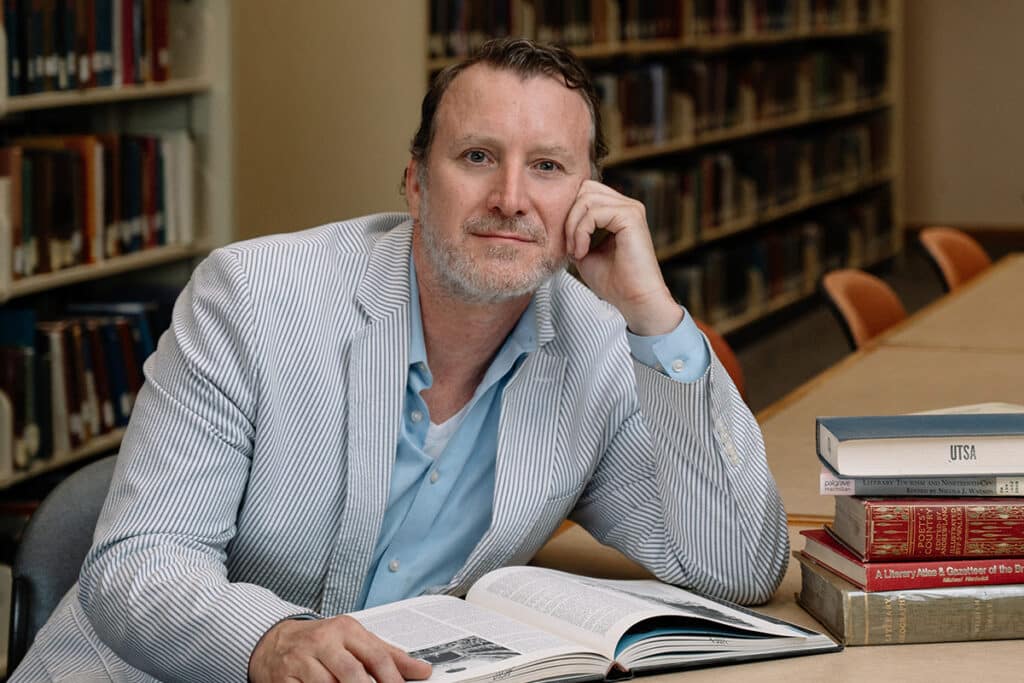As a newly-minted urban planner, I’ve had the honor of serving as a volunteer for Hemisfair since June of 2011. Because it rests so deeply in my heart, I think about it daily and never tire of telling its extraordinary story. We imagine Hemisfair to be the city’s “front porch” — a welcoming place of entry, in which to relax and reconnect with neighbors. While these dreams may be big, so are the efforts behind it. And while plans, vision and development are an important part of any major project, among the most important and magical components of Hemisfair are its people — many whom are women — who volunteer their time, energy and resources to make this progress possible. These “Women of Hemisfair”arrive from a variety of backgrounds and expertise and have enthusiastically jumped on board and committed themselves to this extraordinary journey. They are the golden threads woven permanently into the fabric of what will ultimately transform our entire community.
Hemisfair
“Great cities have great downtowns.” It would be difficult to dispute this statement, imagining the grand urban centers across the globe — Paris. Mexico City. Barcelona. New York. Buenos Aires. Upon arrival, tourists don’t ask taxis to whisk them to a suburban mall — they instead flock to the city’s center, where energy and life abound. And in each of these cases, urban parks also populate these city centers as a place to meet, to relax, to enjoy the company of others or reflect by one’s self. That’s what we dream for Hemisfair. As Hemisfair CEO Andres >Andujar is fond of saying, “Great downtowns have great urban parks.”
Andujar is an architectural engineer with three decades of development experience in the United States and abroad.
We’re on our way, but we’re not there yet. It’s a paradox; despite climbing to the coveted spot as the seventh-largest city in the country, the social lives of committed residents have flocked to the outskirts of San Antonio, creating a doughnut-like development pattern. Now, with collective vision and intent led by Mayor Julián Castro, efforts are being kick-started to reinvigorate downtown with fresh ideas and energy, with Hemisfair as a major priority. In 2010, Mayor Castro declared that it was the Decade of Downtown. The subsequent redevelopment plans for Hemisfair are a critical component in this vision to ignite downtown redevelopment and encourage citizens to return to the urban core.
Hemisfair’s 100-plus-acre parcel is essentially an urban site, planted squarely in the center of the city and hidden behind the Convention Center. Currently surrounded by fencing and walls, it’s an area many find relatively unwelcoming and difficult to locate. But that’s all about to change. In September of 2009, the San Antonio City Council voted to incorporate the Hemisfair Park Area Redevelopment Corporation (HPARC) for the purposes of “acquiring property, planning, developing, constructing, managing, maintaining and financing projects within Hemisfair and the areas adjacent to or near the existing park.” Guided by an 11-member board of directors, the Hemisfair team is intent on fostering community-wide impact. This will be achieved, explains Andujar, by recognizing the campus as critical connecting tissue between previously disengaged sectors of the urban core. Debra Guerrero, vice president-development of NRP Group and an HPARC board member, has long been immersed in the improvement of San Antonio. With tenure on City Council from 1997 to 2001, and now serving on the SAISD board, Guerrero understands the impact of pride that results from projects that serve everyone. “My mother worked at HemisFair … it was such a memorable experience for her. She often talked about how proud she was of the city where she grew up and how this international festival was a turning point,” she says. “I felt this same sense of pride when the mayor asked if I’d participate on the board.”
Guerrero cites a lack of a cohesive development plan for the park over the past 45 years that has created special challenges. “This is now being addressed to deliver our community’s vision for a transformative park,” she says. “The community desires a central gathering place for activities; they demand public open space for recreation and relaxing; they thirst for more downtown living options in a mixed-use environment that’s pedestrian and bike friendly. That’s what we want to deliver to them.” She insists that Hemisfair is poised to be this new place our community hungers for. “Of course, we couldn’t do this without the leadership and commitment of the mayor and the city manager and the buy-in of the community.”
History
Serving as a San Antonio City Councilwoman during the term of Mayor Walter W. McAllister, from 1963to1970, Lila Cockrell was poised in the catbird seat as plans for HemisFair ’68 began to unfold. “It was one of the most exciting times to be a part of city government, working in partnership with the HemisFairexecutive committee and local business community,” she remembers. “It was a tremendous challenge for a city of our size (at that time) to undertake putting on a world’s fair, but as a result, it moved our city forward and began the momentum to address further economic development efforts and progress toward the city we have become today.” She details the nearly overwhelming schedule of activities for opening day, and one particularly humorous experience: “I remember dashing home to change for the black-tie event at the Theater for the Performing Arts (later renamed the Lila Cockrell Theater). Margaret Tobin and her son, Robert Tobin, had underwritten the performance of the opera Don Carlo, and it was scheduled to start early in the evening with Act I, then recess for an elegant dinner in the foyer of the theater, served by Catering by Rosemary. We were then to return to our seats in the theater and continue with the next three acts.
“However, long days, fine food and beverages and a dark room are dangerous partners. As we watched the opera unfold, I was able to observe heads beginning to slump forward, followed by an obvious effort to try to stay alert. By the start of Act III, members of the audience had started quietly slipping out to head for home, just too exhausted to stay the course. I’ll have to admit that my husband and I also slipped out before the final curtain, but with wonderful memories of a very exciting day.”
Volunteers
Volunteers are the spine of Hemisfair; Andujar knows that even a dedicated staff can’t do it alone. “There is immense community love for Hemisfair, as the ’68 fair touched so many lives in meaningful ways. We are fortunate to be the recipients of that community passion through thousands of hours of professional volunteer time,” he says. Ashley Solcher Hixon, divisional operating officer, Methodist Healthcare System and HPARC board member and volunteer, is a sixth-generation SanAntonian with a special connection to Hemisfair. “My great-grandfather was Walter W. McAllister, who served as mayor during this time,” she says. “I remember thinking that I knew my neighborhood and therefore the city — and then my grandmother took me up into the Tower of the Americas and said THIS is San Antonio. It made such an impact.” Solcher Hixon says she’s pleased that first and foremost, Hemisfair is built for locals: “The redevelopment plan links the campus not only to downtown and its major assets, but also to adjacent neighborhoods.” And as a mother of two small children, she’s gratified that what was once such a special place will be restored with a tremendous residual effect on downtown.
With plans calling for increased park area, plazas, open space, art and cultural space, Hemisfair public relations and organizational strategies volunteer Celine Casillas Thomasson is thrilled that the park will soon be bursting with San Antonians, in much the same way it did for the first HemisFair. “The summer of ’68 was one of the best childhood memories. So many friends came to visit, it was fantastic,” she recalls. “I began volunteering at Hemisfair, offering my professional expertise because I was captivated with the idea that Hemisfair could do this again, but in a long-term, sustainable manner.” With planned enhancements to the Magik Theater and greater visibility for cultural and educational institutions like UNAM, Instituto Cultural de Mexico and the Institute of Texan Cultures, Hemisfair will offer a rich collaboration of experiences for these iconic neighbors. But it’s not just about 1968. Hundreds of years of history permeate the site, with the remnant of theAcequia Madre and a handful of 19th-century historic homes residing within Hemisfair’s footprint. Andujarand his team are genuinely committed to paying respect to the many layers of the Hemisfair site. Sue Ann Pemberton, an HPARC board member and an architect specializing in historic preservation projects, shares her expertise and commitment to the area’s history. Recently completing research and as the board member overseeing the restoration of the Eagar House complex, she has served as a vital resource for the project’s historical interests, says Omar Gonzalez, HPARC director of planning, development and operations.
Pemberton explains the imperative nature of breathing life into the site’s historic structures and how key it is to the vision of Hemisfair’s redevelopment. “We aim to create a vital mixed-use area, centered on a city park that maintains and revitalizes the historic buildings while reconnecting the area to the adjacent neighborhoods and providing new development compatible in scale with adjacent properties.” She adds that the park will offer many special places and uses — some active, some quiet. “We see Hemisfair as an accessible neighborhood park that unifies the city, serves as a community gathering place and provides an opportunity for citizens to work, live and play. We want our historic spaces to play a role in the present.”
Today
With a vision in place and a City Council-approved master plan, the Hemisfair team is already shifting into second gear, with funds nimbly allocated for critical projects with traction. Hemisfair’s municipal investment is being used to kick off the first phase of the development program. It covers the following: reconstruction of perimeter roadways for conversion into complete streets, partial reinstatement of the historical Hemisfair street grid, restoration of historic structures, renovation and expansion of the play environment and the design of the civic park, the most iconic element of the redevelopment. One of the first areas of reinvigoration is what’s currently being dubbed as Plaza de Artes. Rachel Holland,HPARC’s administrative assistant who leads Hemisfair’s special projects, shares her excitement for the vision. “The existing playground will be redeveloped into a play district, including areas of recreation for children of all ages,” she explains. The 27-year-old native San Antonian returned home to join HPARC’sfour-person staff earlier this year. She explains her passion for helping deliver a world-class development that her contemporaries are begging for.
“Hemisfair will be that vibrant and memorable district that attracts young creative types back home from cities like San Francisco and Austin,” she continues. “Once people are living in Hemisfair, I imagine strolling down a picturesque block to meet my friends on a charming patio or working on my laptop under a tree in the park. My goals for Hemisfair are to help create this vibrant community that fosters more opportunities for young professionals, and inspires a hip, fresh and urban direction for the entire city.”
Connection
Andujar explains that since HPARC already maintains control of the western side of the campus, the bulk of the city’s investment will focus on South Alamo Street, between Cesar Chavez Boulevard and Market Street. As it is a highly visible area, the transformation and transition of this area will be the most visible indicator of HPARC’s commitment to the expansion and improvement of open space at Hemisfair. In addition, the Hotel Occupancy Tax (HOT) will assist in converting this commitment to reality. HOT will fully fund the planned expansion of the Henry B. Gonzalez Convention Center and subsequent demolition of the western portion of the center, leaving a giant footprint for the largest park space in downtown San Antonio. “Opening the northwest corner of the campus changed our charge from bringing people to the park, to bringing the park to the people,” claims Andujar, in reference to the planned 10-acre civic park. At the corner of Alamo and Market Streets, where brick walls and driveways currently exist, a green lawn and plans for an open-air amphitheater, framed by mixed-use development, will open their arms to the city and welcome them into Hemisfair by 2017.
Many may have heard the term “complete streets” creeping into the vernacular; but what exactly does it mean and why is a park so interested in streets? Complete streets is an effort (supported by policy) to ensure that transportation planners and engineers design the streets with all users in mind. Hemisfair is an active partner in a newly funded complete streets project at Chavez and South Alamo. Incorporating diverse pedestrian spaces and complete streets, Hemisfair will have a hand in positively shaping its surrounding environment. Whether approaching by foot or wheel, using the street should be a positive experience. Thinking about the way streets are designed is a way to “humanize” the perimeters of Hemisfair and increase safety and connectivity — the icing on the cake, so to speak. Part of Hemisfair’s intended connectivity calls for removing the current island effect caused by the surrounding park barriers, which, like an octopus, reach out to the surrounds in all directions. WithHemisfair’s embrace, connectivity will be enhanced by reinstating part of the historic street grid removed to form the HemisFair campus in 1968 and forging solid bonds with the Lavaca and Denver Heights neighborhoods via pedestrian, bike and vehicular connections. Improving the pedestrian connections to the neighborhoods to the east is a priority, and plans call for expanding and softening the passages at Commerce, Montana and Chavez Streets and IH-37. Looking inward towards downtown, Hemisfair plans also call for increased pedestrian connectivity between Hemisfair, the Convention Center, the Alamo and La Villita, and creating clear portals to the River Walk at the Park and on Market, South Alamo, Nueva and Chavez Streets.
And while connectivity is essential, so is temperature. Andujar adds, “So is greening of the area to help with the ‘heat island effect.'” To this end, 400 trees will be added to Chavez and South Alamo, having the park effectively cross the street so that as drivers enjoy a canopy of shade, visitors realize that they have arrived at a very special place — the Front Porch of San Antonio.
Impact
Hemisfair is destined to be a people magnet for both locals and visitors, translating into a redevelopment that spawns a powerful urban economic generator. HPARC’s Gonzalez details that an anticipated half-billion dollars in direct private investment is expected, re-energizing new residential and business development opportunities. “Private investment will be incorporated in the form of public-private partnerships (P3s). Through these P3 relationships, HPARC will act as a horizontal developer, delivering high-density, residential, mixed-use developments,” he says. “HPARC will contribute the land, utilities, environmental clearances and entitlements, while the private developer will contribute finance, design, construction and operation for these rental projects. Because we’re a nonprofit, HPARC’s profits will be reinvested in Hemisfair, and our returns will be measured by how we transform San Antonio.”
“I really feel we’re at a crossroads now — we’re creating an urban revolution,” adds Guerrero. She’s emphatic that Hemisfair will not only enhance the urban core, but create a trickle-down effect for all of the near-downtown neighborhoods surrounding it. “Coming from the South Side, just two exits away, I already feel the excitement. This investment is for all citizens on all sides of the city. We’ll reap the economic development benefits, of course. More importantly, it also instills a sense of pride … Hemisfair really is for everyone.”
Andi Rodriguez is an urban planner at Kell Munoz Architects and was the first volunteer at the




